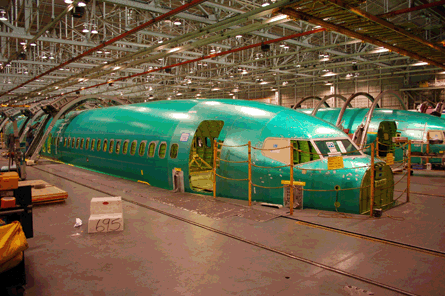Boeing has confirmed that it will follow Airbus's lead with an increase in its single-aisle production, but analysts continue to warn that rates are too high.
Monthly output of the Boeing 737 will be boosted by 2.5 units to reach 34 by early 2012, as a result of greater customer demand, says the airframer. Airbus is already increasing A320 family production from 34 aircraft a month to 36 from December, partly reversing last year's move to cut the planned rate rise to 40.
Boeing says that it "continues to study further potential 737 rate increases, given continued customer demand". With Airbus having recently indicated that further A320 rises could be on the horizon, concern remains in some quarters that production needs to be tempered.
Research by the financial services company UBS reveals that while the number of in-production parked airliners has remained unchanged, the high level indicates that too many aircraft are littering the market.
 |
|---|
© Spirit Aerosystems |
"We believe the large number of parked in-production aircraft is evidence of oversupply in the system," says UBS, which indicates the number of parked in-production types "remains near peak levels".
Of the 372 aircraft, UBS estimates 173 units, or 47%, are 10 years old or younger, including 112 units, or 30%, that are five years or younger.
Looking at in-production narrowbodies, specifically the A320 family and Next Generation 737, UBS estimates that 97 units, or 55%, are 10 years old or younger. These aircraft include 55 A320s and 42 737NGs. Units that are five years old or younger represent 57 aircraft, or 32%, comprising 30 A320s and 27 737NGs.
UBS estimates there were 2,758 parked airliners at the end of April, similar to the month before, and consistent with the seasonal trend during the last 10 years. Although this tally "remains near its all-time high in absolute terms", it is 12.4% of the installed base and therefore below the 13.5% peak in 2002. Of the North American fleet, 15% is parked, compared with 12% of the European fleet and 6% of the Asian fleet.
The first Boeing 737NG is to be broken for parts. The aircraft is an 11-year-old 737-600 powered by CFM International CFM56-7B20/2 engines (MSN 28303), which has been ferried to Kemble in the UK for disassembly by Air Salvage International. Originally delivered to Scandinavian Airlines, the 737 is owned by the administrators of Flyglobespan. Flightglobal's ACAS database shows 69 737-600s currently in service with nine operators.
Source: Flight International



















